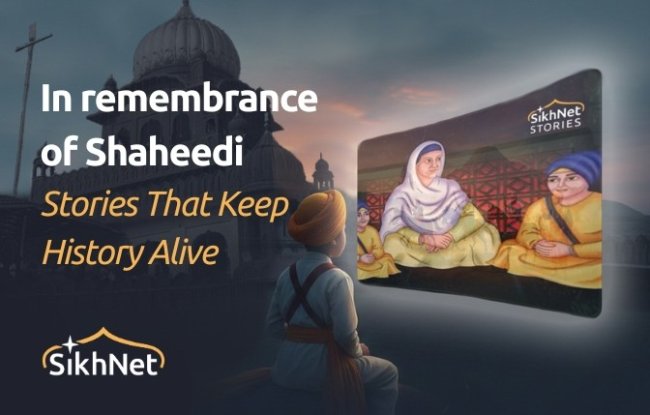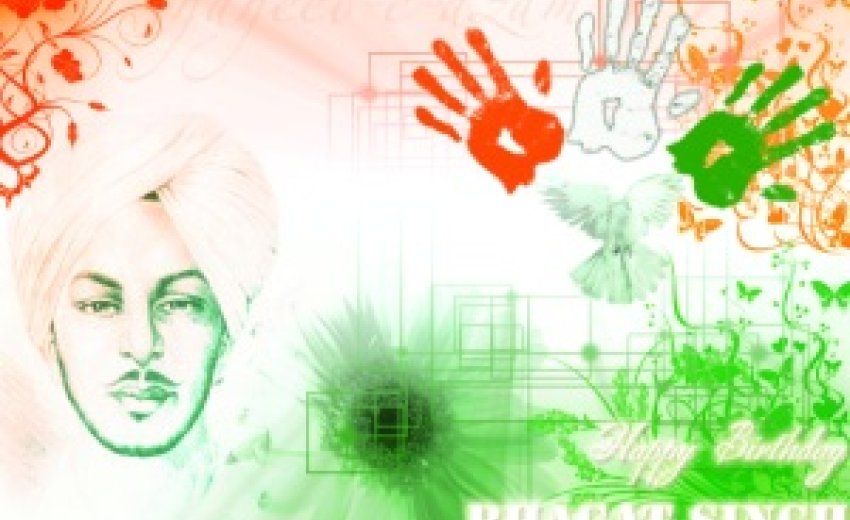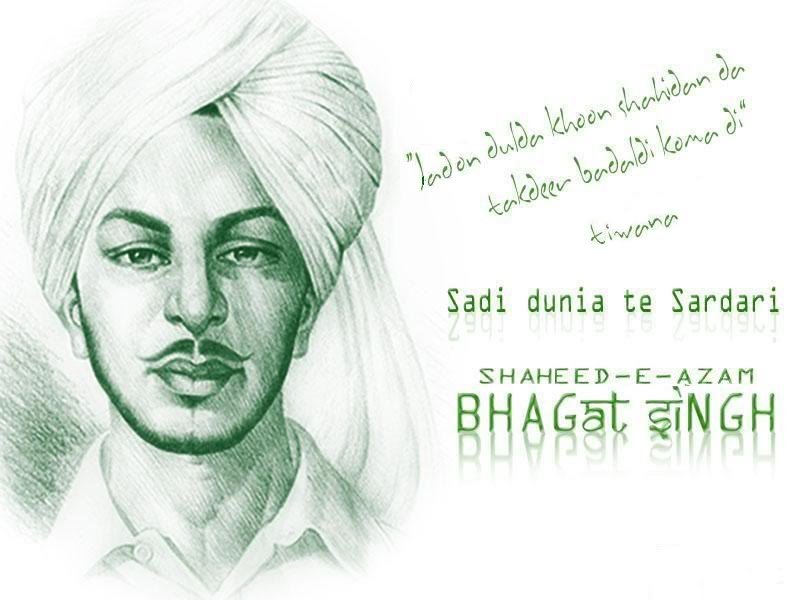
Many who stood on the threshold of death said they saw their whole life pass in front of them as if in fast motion. And they also spoke of a dark tunnel that quickly turned into a spiral of light and carried them into a world in which peace and happiness covered everything like fields of flowers. Śahīd-e-Āzam Bhagat Singh could not tell anyone of such an experience, for there was no way back for him when on March 31, 1931 he stood under the gallows, condemned to death. But as he had used his heart, the strongest of all weapons, to fight for his country's freedom, it is very likely that death made the journey into the light easy for him.
Bhagat Singh was a revolutionary and martyr. He was born into a family of Sikh farmers in the village Baṅgā in the district of Lāilpur on September 27, 1907. His whole family had committed themselves to patriotism, reform and the freedom of their country. As this was relentlessly persecuted by the Brits, Kiśan Singh, who was connected with the Canal Colonization Bill, in which his brother played a leading role, was in prison when his wife Vidiāvatī held her second-born son in her arms for the first time. Nobody can stop dawn, and the two brothers supported the Gadar Party campaign in 1914 and 1915. Bhagat Singh's soul, growing up in this atmosphere of freedom, must have sensed the meaning of Śahīd Sardār Kartār Singh Sarābhā's execution, which he would never forget.
Having finished the fifth form of his village school, Bhagat Singh continued his education at the Dayanand Anglo Vedic School in Lāhaur. Here he became aware of the appeal, issued by Mahātmā Gāndhī and other nationalistic leaders, to avoid all institutions connected to the Brits. Bhagat Singh took this appeal to heart and, having very successfully sat the entrance examination, matriculated at the National College in Lāhaur. Just as he was preparing for his B. A. examinations, his parents told him that they were planning his marriage, which he thought unsuitable: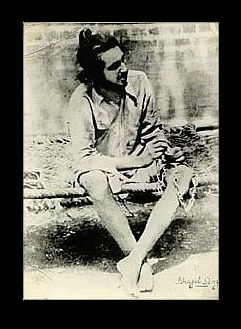 "If this wedding is to take place in enslaved India, only death shall be my bride."
And the bride he meant rose, put on her wedding dress and came to meet him on the road of life. As Bhagat Singh did not want to speak with his father about a possible marriage, he left his parents' house, went to Kānpur and took up work with Pratap Press. He read revolutionary writings and joined the Hindustan Republican Association, a radical group that later turned into the Hindustan Republican Socialist Association. When he received the news from home that he did not have to marry any more, he returned at once. This was in 1925, the year in which he also protested against the deposition of Mahārājā Ripudaman Singh of Nābhā, who was a sympathizer of the Akālī, by the British government. This led to an arrest warrant being issued for him. He was able to flee to Dillī and, using the assumed name Balvant Singh, started working for the daily paper Vīr Arjun. Only five months later Bhagat Singh could return to Lāhaur, where he at once contacted the Kirtī Kisān Pārṭī and started working for this Party's newspaper, Kirtī, without relinquishing his connection with the Hindustan Republican Socialist Association. When the Naujavān Bhārat Sabhā was founded in March 1927 he became its secretary.
"If this wedding is to take place in enslaved India, only death shall be my bride."
And the bride he meant rose, put on her wedding dress and came to meet him on the road of life. As Bhagat Singh did not want to speak with his father about a possible marriage, he left his parents' house, went to Kānpur and took up work with Pratap Press. He read revolutionary writings and joined the Hindustan Republican Association, a radical group that later turned into the Hindustan Republican Socialist Association. When he received the news from home that he did not have to marry any more, he returned at once. This was in 1925, the year in which he also protested against the deposition of Mahārājā Ripudaman Singh of Nābhā, who was a sympathizer of the Akālī, by the British government. This led to an arrest warrant being issued for him. He was able to flee to Dillī and, using the assumed name Balvant Singh, started working for the daily paper Vīr Arjun. Only five months later Bhagat Singh could return to Lāhaur, where he at once contacted the Kirtī Kisān Pārṭī and started working for this Party's newspaper, Kirtī, without relinquishing his connection with the Hindustan Republican Socialist Association. When the Naujavān Bhārat Sabhā was founded in March 1927 he became its secretary.
On October 30, 1928 the sun of freedom was already very high on the Indian horizon, burning down on the Brits. For, in spite of the strict prohibitions, demonstrations against them and against the Indians having no say in the government of their own country were taking place more and more frequently. And when a commission was installed under the chairmanship of Sir John Simon to report on the political events and the unrest, again not a single Indian was a member of this commission, and it was decided to hold demonstrations in all big cities of India as an All-in-One Party. In Lāhaur, Lālā Lājpat Rāe and Paṇḍit Madan Mohan Mālvīā led the silent protest march to the station. The police chief, a Mr Scott, knew nothing but his regulations, and the peaceful protest of thousands of Indians enraged him so that he took a Lāṭhī (a stick made of bamboo) and used it to batter Lālā Lājpat Rāe's head. He did not even stop when Lālā Lājpat Rāe had fallen down under his powerful blows. The quiet freedom fighter soon after succumbed to his severe injuries.
Bhagat Singh was eyewitness to this horrible deed and together with Śivrām Harī Rājgurū and Sukhdev Thāpar swore to take revenge. But there was a tragic mistake, and instead of Mr Scott he killed a young officer called J.P. Saunders. To escape being arrested and condemned to death, Bhagat Singh, being a wealthy man, fled to Kalcattā. And the bride I mean put on her Dupaṭṭā and drew closer to him on the road of life.
The young revolutionary's heart was not made for resting, and when he heard that on April 8, 1928, the Public Safety Bill and the Trade Disputes Bill were to be debated in Dillī, he felt unable to stay in hiding any longer. The group centered around Bhagat Singh decided that he and Baṭukeśvar Datt would set off harmless explosive charges in the Central Assembly Hall during the opening session. The charges could not harm anyone and were only designed to draw attention to the fact that the oppression of India could be tolerated no more. And so, when the session was about to begin, they threw the first charge behind a bank on which sat members of the Assembly, and when this charge exploded, they threw the second one. Shouting their political slogans and throwing leaflets into the Assembly, they were arrested and then taken to prison.
On April 15, the Lāhaur 'bomb factory' was discovered by the police, leading to the arrest of other members of HRSA. Seven of them turned informants, and the police could connect Bhagat Singh and his friends with the death of Saunders and charged them with murder. Bhagat Singh was imprisoned in the Mīānvālī Jelh in Lāhaur, where he and other inmates began a hunger strike to protest against the unequal treatment of Indian and European prisoners. He was still on hunger strike when the first trial against him began on July 10, 1929, and only stopped it after J.N. Dās's death on September 13, 1929, when this event led to better conditions for all prisoners.
Bhagat Singh used the first trial of a British tribunal against him on July 10, 1929, as well as the second trial on October 7, 1930, in which he was condemned to death, not for defending himself, but for promoting Indian independence. Bhagat Singh accepted his death sentence with calm dignity, while next to his bowed head stood the bride I mean, almost able to touch his hand on the road of life.
Bhagat Singh did not object to the death sentence, but he protested against the mode of execution: He wanted to be shot, like a soldier, instead of being hanged like a common criminal. His wish was refused.
On March 31, 1931, Bhagat Singh, only twenty-five years old, stands beneath the gallows, embracing the rope and perhaps seeing his whole life pass in front of him. Death may have drawn the curtain of the future away for the man about to die, and he may have seen that his death was not in vain as evening falls on British rule in India, and that his country will soon receive freedom at midnight. And he - he is one of the pioneers of this freedom, and will live as long as his India lives. Suddenly Bhagat Singh sees her standing at the end of the road of his life: the bride that I mean. She has raised her head underneath the Dupaṭṭā and looks at him. She has the most beautiful eyes, and around her lips plays a loving smile. Only a single moment lies between her and him. Once more he utters "Down with British imperialism!" - his favourite slogan. And the next moment he is already on his way into the light, together with the bride that I mean.
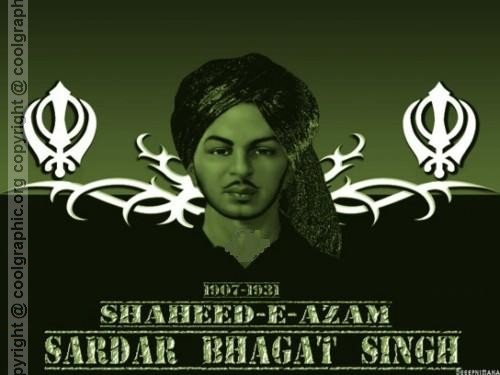
The execution of Bhagat Singh, now Śahīd-e-Āzam Bhagat Singh, led to storms of protest all over India. The fact that the British colonialists burned his body secretly and under police supervision in Husainvālā shows how their power had already gone from them. As despite of this it had become known where the cremation would take place, his friends went there the next day, collected his mortal remains and threw his ashes into the Rāvī. They also organised a procession in Lāhaur to honour Śahīd-e-Āzam Bhagat Singh, and many people were deeply moved by this event. He became a hero to innumerable people, a man to be emulated, and many songs told of his life. In 1950, after the Brits had left and there was a state of India and a state of Pākistān, to which Lāhaur now belonged, Śahīd-e-Āzam Bhagat Singh's mortal remains and those of his comrades were transferred home to India and a monument was erected to honour all of them. Since March 23, 1961, an annual festival is celebrated to commemorate them.
~ Elisabeth Meru
Related story: Elisabeth Meru - The Journey Home
